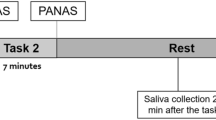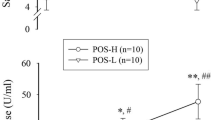Abstract
It has been documented that cortisol release in response to acute stressors is reduced in patients with atopic dermatitis, allergic rhinitis, and other atopic diseases compared to that in healthy subjects. We aimed to test the hypothesis that atopic patients exert reduced salivary cortisol awakening response (CAR) in comparison with healthy subjects. The hypothesis was tested on a stressful and a relax day selected subjectively. Moreover, we evaluated the impact of trait anxiety. The sample consisted of 60 subjects, out of which 28 were patients with atopy and 32 healthy volunteers of both sexes. Saliva samples were collected in the morning to evaluate CAR as well as in the early afternoon and evening to look at cortisol concentrations during the rest of the day. The results showed reduced CAR in atopic patients compared to that in healthy subjects. This effect was modulated by sex with a significant difference observed in males. While CAR was reduced, atopic patients had unchanged cortisol concentrations throughout the day. The evening cortisol was even higher in atopic patients. If the subjects were stratified according to the trait anxiety, no significant differences in CAR between high and low anxiety were observed. No differences in cortisol variables including CAR were observed between the stressful and relax day. In conclusion, this study presents evidence on reduced CAR suggesting an insufficient HPA axis reactivity in atopy. Furthermore, the data in atopic patients demonstrate that reduced HPA axis reactivity does not necessarily mean lower cortisol concentrations throughout the day. This might be of relevance to immune system function and the course of the disease.


Similar content being viewed by others
Notes
\( \mathrm{MnInc}=\left(\frac{S2+S3}{2}-S1\right) \)
\( {\mathrm{CARAUC}}_{\mathrm{G}}=\left(\frac{S2+S1}{2}+\frac{S3+S2}{2}\right) \)
Abbreviations
- AUCG :
-
Area under the curve relative to ground
- CAR:
-
Cortisol awakening response
- HPA:
-
Hypothalamic-pituitary-adrenocortical axis
- MnInc:
-
Mean increase
- PSS:
-
Perceived stress scale
- STAI-T:
-
State and trait anxiety inventory-trait version
References
Buske-Kirschbaum A, Jobst S, Wustmans A, Kirschbaum C, Rauh W, Hellhammer D. Attenuated free cortisol response to psychosocial stress in children with atopic dermatitis. Psychosom Med. 1999;59(4):419–26.
Buske-Kirschbaum A, Geiben A, Höllig H, Morschhäuser E, Hellhammer D. Altered responsiveness of the hypothalamus-pituitary-adrenal Axis and the sympathetic Adrenomedullary system to stress in patients with atopic dermatitis. J Clin Endocrinol Metabol. 2002;87(9):4245–51.
Buske-Kirschbaum A, Ebrecht M, Hellhammer DH. Blunted HPA axis responsiveness to stress in atopic patients is associated with the acuity and severeness of allergic inflammation. Brain Behav Immun. 2010;24(8):1347–53.
Wamboldt MZ, Laudenslager M, Wamboldt FS, Kelsay K, Hewitt J. Adolescents with atopic disorders have an attenuated cortisol response to laboratory stress. J Allergy Clin Immunol. 2003;111(3):509–14.
Hlavacova N, Solarikova P, Marko M, Brezina I, Jezova D. Blunted cortisol response to psychosocial stress in atopic patients is associated with decrease in salivary alpha-amylase and aldosterone: focus on sex and menstrual cycle phase. Psychoneuroendocrinology. 2017;78(1):31–8.
Chrousos GP, Kino T. Glucocorticoid action networks and complex psychiatric and/or somatic disorders. Stress. 2007;10(2):213–9.
Segerstrom SC, Miller GE. Psychological stress and the human immune system: a meta-analytic study of 30 years of inquiry. Psychol Bull. 2004;130(4):601–30.
Hashizume H, Takigawa M. Anxiety in allergy and atopic dermatitis. Curr Opin Allergy Clin Immunol. 2006;6(5):335–9.
Buske-Kirschbaum A, Ebrecht M, Kern S, Gierens A, Hellhammer DH. Personality characteristics in chronic and non-chronic allergic conditions. Brain Behav Immun. 2008;22(5):762–8.
Jezova D, Makatsori A, Duncko R, Moncek F, Jakubek M. High trait anxiety in healthy subjects is associated with low neuroendocrine activity during psychosocial stress. Prog Neuro-Psychopharmacol Biol Psychiatry. 2004;28(8):1331–6.
Krieger DT. Rhythms of ACTH and corticosteroid secretion in health and disease, and their experimental modification. J Steroid Biochem. 1975;6(5):785–91.
Jezova D, Vigas M. Apomorphine injection stimulates beta-endorphin, adrenocorticotropin, and cortisol release in healthy man. Psychoneuroendocrinology. 1988;13(6):479–85.
Spath-Schwalbe E, Scholler T, Kern W, Fehm HL, Born J. Nocturnal adrenocorticotropin and cortisol secretion depends on sleep duration and decreases in association with spontaneous awakening in the morning. J Clin Endocrinol Metab. 1992;75:1431–5.
Wust S, Federenko I, Hellhammer DH, Kirschbaum C. Genetic factors, perceived chronic stress, and the free cortisol response to awakening. Psychoneuroendocrinology. 2000;25(7):707–20.
Fries E, Dettenborn L, Kirschbaum C. The cortisol awakening response (CAR): facts and future directions. Int J Psychophysiol. 2009;72(1):67–73.
Clow A, Hucklebridge F, Stalder T, Evans P, Thorn L. The cortisol awakening response: more than a measure of HPA axis function. Neurosci Biobehav Rev. 2010;35(1):97–103.
Thorn L, Hucklebridge F, Evans P, Clow A. Suspected non-adherence and weekend versus week day differences in the awakening cortisol response. Psychoneuroendocrinology. 2006;31(8):1009–18.
Hellhammer J, Fries E, Schweisthal OW, Schlotz W, Stone AA, Hagemann D. Several daily measurements are necessary to reliably assess the cortisol rise after awakening: state- and trait components. Psychoneuroendocrinology. 2007;32(1):80–6.
O’Connor DB, Hendrickx H, Dadd T, Elliman TD, Willis TA, Talbot D, et al. Cortisol awakening rise in middle-aged women in relation to psychological stress. Psychoneuroendocrinology. 2009;34(10):1486–94.
Pruessner JC, Wolf OT, Hellhammer DH, Buske-Kirschbaum A, Von Auer K, Jobst S, et al. Free cortisol levels after awakening: a reliable biological marker for the assessment of adrenocortical activity. Life Sci. 1997;61(26):2539–49.
Therrien F, Drapeau V, Lupien SJ, Beaulieu S, Doré J, Tremblay A, et al. Awakening cortisol response in relation to psychosocial profiles and eating behaviors. Physiol Behav. 2008;93(1–2):282–8.
Walker S, O’Connor DB, Schaefer A, Talbot D, Hendrickx H. The cortisol awakening response: associations with trait anxiety and stress reactivity. Personal Individ Differ. 2011;51(2):123–7.
Portella MJ, Harmer CJ, Flint J, Cowen P, Goodwin GM. Enhanced early morning salivary cortisol in neuroticism. Am J Psychiatr. 2005;162(4):807–9.
Vink NM, Boezen HM, Postma DS, Rosmalen JG. Basal or stress-induced cortisol and asthma development: the TRAILS study. Eur Respir J. 2013;41(4):846–52.
Schut C, Weik U, Tews N, Gieler U, Deinzer R, Kupfer J. Psychophysiological effects of stress management in patients with atopic dermatitis: a randomized controlled trial. Acta Derm Venereol. 2013;93(1):57–61.
Duncko R, Makatsori A, Fickova E, Selko D, Jezova D. Altered coordination of the neuroendocrine response during psychosocial stress in subjects with high trait anxiety. Prog Neuro-Psychopharmacol Biol Psychiatry. 2006;30(6):1058–66.
Mullner J, Ruisel I, Farkas G. Príručka pre administráciu, interpretáciu a vyhodnocovanie dotazníka na meranie úzkosti a úzkostlivosti. Bratislava: Psychodiagnostické a didaktické testy; 1980.
Cohen S, Kamarck T, Mermelstein R. A global measure of perceived stress. J Health Soc Behav. 1983;24(4):385–96.
Stalder T, Kirschbaum C, Kudielka BM, Adam EK, Pruessner JC, Wüst S, et al. Assessment of the cortisol awakening response: expert consensus guidelines. Psychoneuroendocrinology. 2016;63:414–32.
Pruessner JC, Kirschbaum C, Meinlschmid G, Hellhammer DH. Two formulas for computation of the area under the curve represent measures of total hormone concentration versus time-dependent change. Psychoneuroendocrinology. 2003;28(7):916–31.
Blackwell E, Carlos F, Mendes De Leon F, Miller G. Applying mixed regression models to the analysis of repeated- measures data in psychosomatic medicine. Psychosom Med. 2006;68:870–8.
Clow A, Thorn L, Evans P, Hucklebridge F. The awakening cortisol response: methodological issues and significance. Stress. 2004;7(1):29–37.
Salome N, Tasiemski A, Dutriez I, Wigger A, Landgraf R, Viltart O. Immune challenge induces differential corticosterone and interleukin-6 responsiveness in rats bred for extremes in anxiety-related behavior. Neuroscience. 2008;151(4):1112–8.
Frank E, Salchner P, Aldag JM, Salomé N, Singewald N, Landgraf R, et al. Genetic predisposition to anxiety-related behavior determines coping style, neuroendocrine responses, and neuronal activation during social defeat. Behav Neurosci. 2006;120(1):60–71.
Clow A, Edwards S, Owen G, Evans G, Evans P, Hucklebridge F, et al. Post-awakening cortisol secretion during basic military training. Int J Psychophysiol. 2006;60(1):88–94.
De Rooij SR, Schene AH, Phillips DI, Roseboom TJ. Depression and anxiety: associations with biological and perceived stress reactivity to a psychological stress protocol in a middle-aged population. Psychoneuroendocrinology. 2010;35(6):866–77.
Dickerson SS, Kemeny ME. Acute stressors and cortisol responses: a theoretical integration and synthesis of laboratory research. Psychol Bull. 2004;130(3):355–91.
Jezova D, Hlavacova N. Endocrine factors in stress and psychiatric disorders: focus on anxiety and salivary steroids. Ann N Y Acad Sci. 2008;1148(1):495–503.
Acknowledgements
The authors thank Ludmila Zilava for excellent laboratory assistance.
Funding
The study was supported by the grant of Slovak Research and Development Agency under the contract nos. APVV-0496-12 and APVV-17-0451; and projects of VEGA 1/0739/17, 2/0057/15, KEGA 085UK-4/2017, and FG05/2017.
Author information
Authors and Affiliations
Corresponding author
Ethics declarations
Conflict of interest
The authors declare that they have no conflict of interests.
Additional information
Publisher’s note
Springer Nature remains neutral with regard to jurisdictional claims in published maps and institutional affiliations.
Rights and permissions
About this article
Cite this article
Rajcani, J., Solarikova, P., Buzgoova, K. et al. Patients with atopy exhibit reduced cortisol awakening response but not cortisol concentrations during the rest of the day. Immunol Res 67, 176–181 (2019). https://doi.org/10.1007/s12026-019-09076-w
Published:
Issue Date:
DOI: https://doi.org/10.1007/s12026-019-09076-w




